Predicting Ceramic Wool Diameter by Motor Frequency Using Improved BP Neural Network
Abstract
:1. Introduction
2. Preparation of the Ceramic Wool
- (1)
- The temperature of the viscous fluid was constant when falling from the directing channel onto the spinning machine;
- (2)
- The viscosity of the viscous fluid was not changed in the fiber forming process;
- (3)
- The viscous fluid possessed constant density for its incompressibility;
- (4)
- The influence of severe temperature and complex physicochemical on the viscous fluid properties was ignored;
- (5)
- The ceramic wool fibers were thrown out along the tangent of the separation point of the roll surface.
3. Experimental Procedure
4. The Calibration of Measurement Model
4.1. LSM Model
4.2. Improved BP Neural Network
5. Practical Examination and Error Analysis
6. Conclusions
- (1)
- The measurement of fiber mean diameter was a very important issue. Theory analysis, simulation analysis, and experiment were used to form a better understanding of the nonlinear problem between motor frequency and fiber mean diameter. The approximate simulation of the fiber formation was discussed, and improved BP neural network based on PSO algorithm was developed to predict the ceramic mean diameter successfully.
- (2)
- A great relationship between the main motor frequency and the ceramic mean diameter was built which had been verified by practical examination. Compared to the nonlinear compensation model based on LSM, the mean measurement error of PSO-BP was 0.471% which was lower than that of LSM. The presented PSO-BP method was very valuable for predicting the wool diameter.
- (3)
- The neural networks could solve nonlinear problems successfully which was certified by the actual prediction of ceramic wool diameter. This shows a bright future in the subsequent wool production.
Author Contributions
Funding
Institutional Review Board Statement
Informed Consent Statement
Conflicts of Interest
References
- Chen, Z.; Chen, Z.; Yang, Z.; Hu, J.; Yang, Y.; Chang, L.; Lee, L.J.; Xu, T. Preparation and characterization of vacuum insulation panels with super-stratified glass fiber core material. Energy 2015, 93, 945–954. [Google Scholar] [CrossRef]
- Chu, S.; Majumdar, A. Opportunities and challenges for a sustainable energy future. Nature 2012, 488, 294–303. [Google Scholar] [CrossRef] [PubMed]
- Wang, S.; Feng, Y.; Huang, Y.; Wu, J.; Ye, Y. A new method of rapid quality detection of vacuum insulation panels. Sci. China Technol. Sci. 2014, 57, 1602–1609. [Google Scholar] [CrossRef]
- Xiao, Y.; Liu, Y.; Li, Y. Status and development of mineral wool made from molten blast furnace slag. Baosteel Tech. Res. 2011, 5, 3–8. [Google Scholar]
- Barati, M.; Esfahani, S.; Utigard, T. Energy recovery from high temperature slags. Energy 2011, 36, 5440–5449. [Google Scholar] [CrossRef]
- Li, L.; Xu, C.; Chang, R.; Yang, C.; Jia, C.; Wang, L.; Song, J.; Li, Z.; Zhang, F.; Fang, B.; et al. Thermal-responsive, super-strong, ultrathin firewalls for quenching thermal runaway in high-energy battery modules. Energy Storage Mater. 2021, 40, 329–336. [Google Scholar] [CrossRef]
- Li, L.; Fang, B.; Ren, D.; Fu, L.; Zhou, Y.; Yang, C.; Zhang, F.; Feng, X.; Wang, L.; He, X.; et al. Thermal-Switchable, Trifunctional Ceramic–Hydrogel Nanocomposites Enable Full-Lifecycle Security in Practical Battery Systems. ACS Nano 2022, 16, 10729–10741. [Google Scholar] [CrossRef]
- Li, B.B.; Chen, Z.F.; Chen, Z.; Qiu, J.; Zhou, Y.Q.; Zhou, J.M. Effect of vitreous fluid temperature on fiber diameter and surface topography of glass wool by centrifugal-spinneret-blow process. Adv. Mater. Res. 2012, 415–417, 1996–2001. [Google Scholar] [CrossRef]
- Clauss, B.; Schawaller, D. Modern aspects of ceramic fiber development. Adv. Sci. Technol. 2006, 50, 1–8. [Google Scholar]
- Ye, X.; Chen, Z.; Zhang, J.; Zhang, P. Two-layer separation technology of melt-spinning ceramic wool. Mater. Res. Express 2018, 5, 115201. [Google Scholar] [CrossRef]
- Li, L.; Jia, C.; Liu, Y.; Fang, B.; Zhu, W.; Li, X.; Schaefer, L.A.; Li, Z.; Zhang, F.; Feng, X.; et al. Nanograin–glass dual-phasic, elasto-flexible, fatigue-tolerant, and heat-insulating ceramic sponges at large scales. Mater. Today 2022, 54, 72–82. [Google Scholar] [CrossRef]
- Zhang, H.; Wang, H.; Zhu, X.; Qiu, Y.-J.; Li, K.; Chen, R.; Liao, Q. A review of waste heat recovery technologies towards molten slag in steel industry. Appl. Energy 2013, 112, 956–966. [Google Scholar] [CrossRef]
- Zhao, D.; Zhang, Z.; Tang, X.; Liu, L.; Wang, X. Preparation of Slag Wool by Integrated Waste-Heat Recovery and Resource Recycling of Molten Blast Furnace Slags: From Fundamental to Industrial Application. Energies 2014, 7, 3121–3135. [Google Scholar] [CrossRef] [Green Version]
- Abtahi, S.M.; Sheikhzadeh, M.; Hejazi, S.M. Fiber-reinforced asphalt-concrete—A review. Constr. Build. Mater. 2010, 24, 871–877. [Google Scholar] [CrossRef]
- Zhao, D.; Zhang, Z.; Liu, L.; Wang, X. A Novel Kinematic Model for Molten Slag Fiberization: Prediction of Slag Fiber Properties. Met. Mater. Trans. A 2014, 46, 993–1001. [Google Scholar] [CrossRef]
- Bajcar, T.; Blagojević, B.; Širok, B.; Dular, M. Influence of flow properties on a structure of a mineral wool primary layer. Exp. Therm. Fluid Sci. 2007, 32, 440–449. [Google Scholar] [CrossRef]
- Gerogiorgis, D.; Panias, D.; Paspaliaris, I. Stochastic modeling and simulation of fiber evolution during melt-blowing slag fiberization. In Proceedings of the Collected Proceedings of the TMS 2012 Annual Meeting (CD), TMS, Warrendale, PA, USA, 11–15 March 2012. [Google Scholar]
- Chelikani, S.; Sparrow, E.M. Numerical Simulations of Plane-Wall Coanda Effects for Control of Fiber Trajectories in the Melt-Blown Process. Ind. Eng. Chem. Res. 2013, 52, 11639–11645. [Google Scholar] [CrossRef]
- Blagojevic, B.; Širok, B.; Hočevar, M. Monitoring and Control of Quality of the Primary Layer of Mineral Wool on a Disc Spinning Machine. Instrum. Sci. Technol. 2003, 31, 63–75. [Google Scholar] [CrossRef]
- Sungkhaphaitoon, P.; Plookphol, T.; Wisutmethangoon, S. Centrifugal Atomization of Zinc Metal Powder for Friction Materials Application. Adv. Mater. Res. 2012, 488–489, 281–285. [Google Scholar] [CrossRef]
- Mencinger, J.; Bizjan, B.; Širok, B. Numerical simulation of ligament-growth on a spinning wheel. Int. J. Multiph. Flow 2015, 77, 90–103. [Google Scholar] [CrossRef]
- Bizjan, B.; Širok, B.; Govekar, E. Nonlinear Analysis of Mineral Wool Fiberization Process. J. Comput. Nonlinear Dyn. 2015, 10, 021005. [Google Scholar] [CrossRef]
- Vad, J.; Morlin, B. Fluid Mechanical Model for Formation of Mineral Wool Fibers Applied in Polymer Composites. Mater. Sci. Forum 2007, 537–538, 269–276. [Google Scholar] [CrossRef]
- Shinjo, J.; Umemura, A. Simulation of liquid jet primary breakup: Dynamics of ligament and droplet formation. Int. J. Multiph. Flow 2010, 36, 513–532. [Google Scholar] [CrossRef]
- Qin, Y.; Lv, X.; Bai, C.; Pan, C.; Guibao, Q.; Jie, Z. Mechanism of Dry Molten Slag Granulation Using a Rotating Multi-Nozzle Cup Atomizer. Steel Res. Int. 2014, 85, 44–52. [Google Scholar]
- Hagiwara, A.; Hobara, N.; Takizawa, K.; Sato, K.; Abe, H.; Naito, M. Microstructure control of SOFC cathodes using the self-organizing behavior of LSM/ScSZ composite powder material prepared by spray pyrolysis. Solid State Ion. 2007, 178, 1123–1134. [Google Scholar] [CrossRef]
- Ma, D.; Zhou, T.; Chen, J.; Qi, S.; Shahzad, M.A.; Xiao, Z. Supercritical water heat transfer coefficient prediction analysis based on BP neural network. Nucl. Eng. Des. 2017, 320, 400–408. [Google Scholar] [CrossRef]
- Huang, L.; Huang, J.; Wang, W. The Sustainable Development Assessment of Reservoir Resettlement Based on a BP Neural Network. Int. J. Environ. Res. Public Health 2018, 15, 146. [Google Scholar] [CrossRef] [Green Version]
- Guo, Y.; Zhao, Z.; Huang, L. SoC Estimation of Lithium Battery Based on Improved BP Neural Network. Energy Procedia 2017, 105, 4153–4158. [Google Scholar] [CrossRef]
- Geng, X.; Lu, S.; Jiang, M.; Sui, Q.; Lv, S.; Xiao, H.; Jia, Y.; Jia, L. Research on FBG-Based CFRP Structural Damage Identification Using BP Neural Network. Photon Sens. 2018, 8, 168–175. [Google Scholar] [CrossRef] [Green Version]
- Eberhart, R.C.; Shi, Y. Comparison between genetic algorithms and particle swarm optimization. In Proceedings of the Evolutionary Programming VII, 7th International Conference, EP98, San Diego, CA, USA, 25–27 March 1998; Springer: Berlin/Heidelberg, Germany, 1998. [Google Scholar]
- Zeng, X.G. A Particle Swarm Optimization Approach for Optimum Design of PID Controller. Mach. Des. Manuf. 2007, 19, 384–391. [Google Scholar]
- Xia, R.; Huang, J.; Chen, Y.; Feng, Y. A study of the method of the thermal conductivity measurement for VIPs with improved RBF neural networks. Measurement 2016, 87, 246–254. [Google Scholar] [CrossRef]
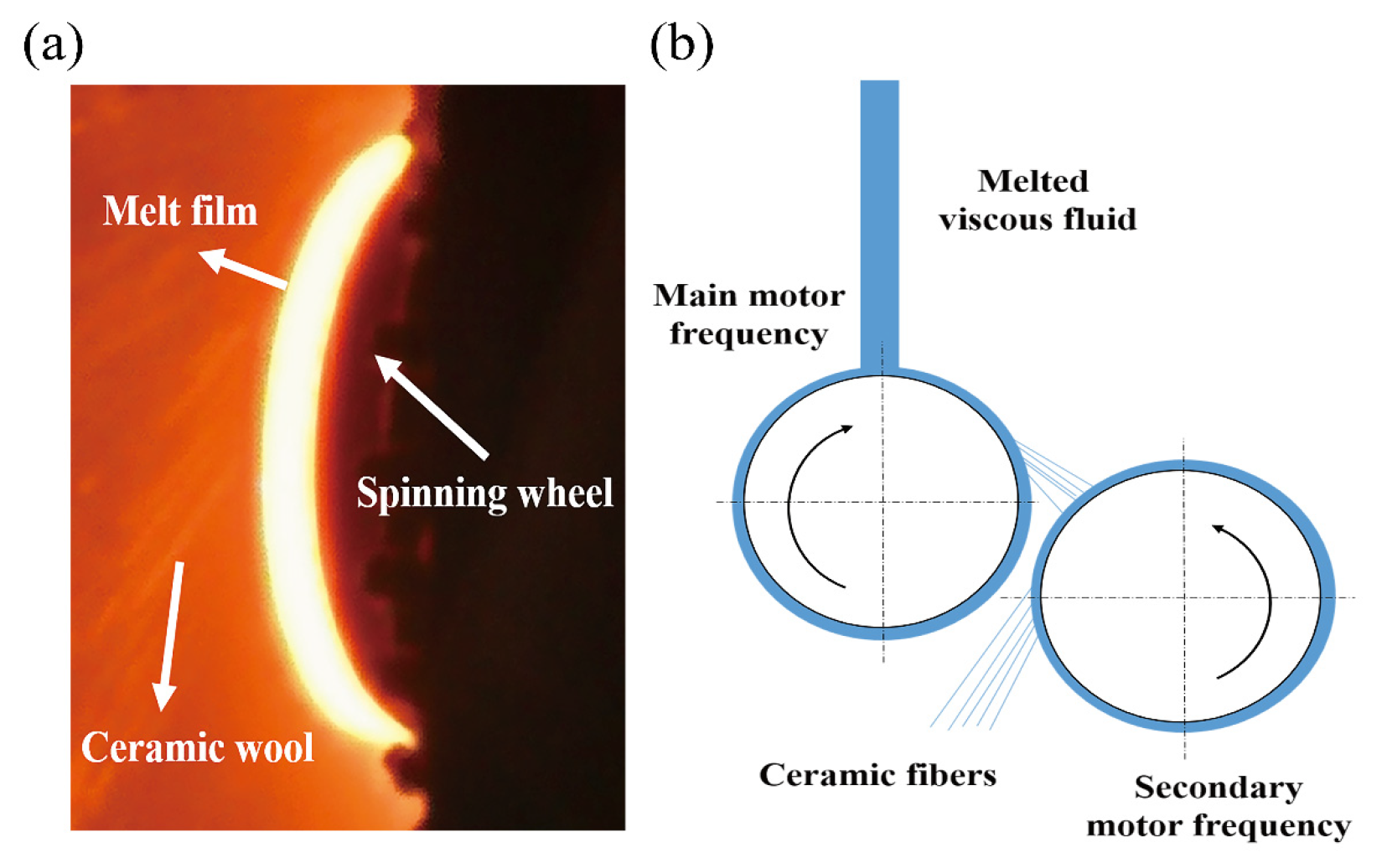
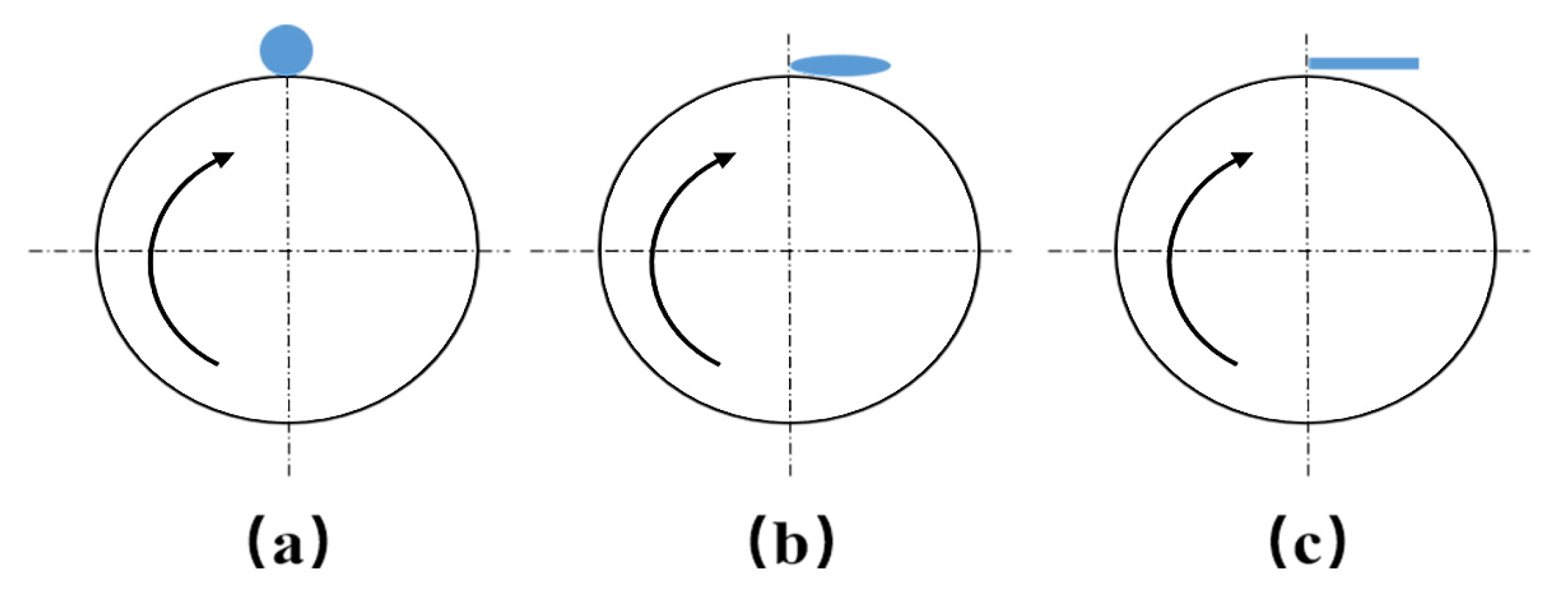
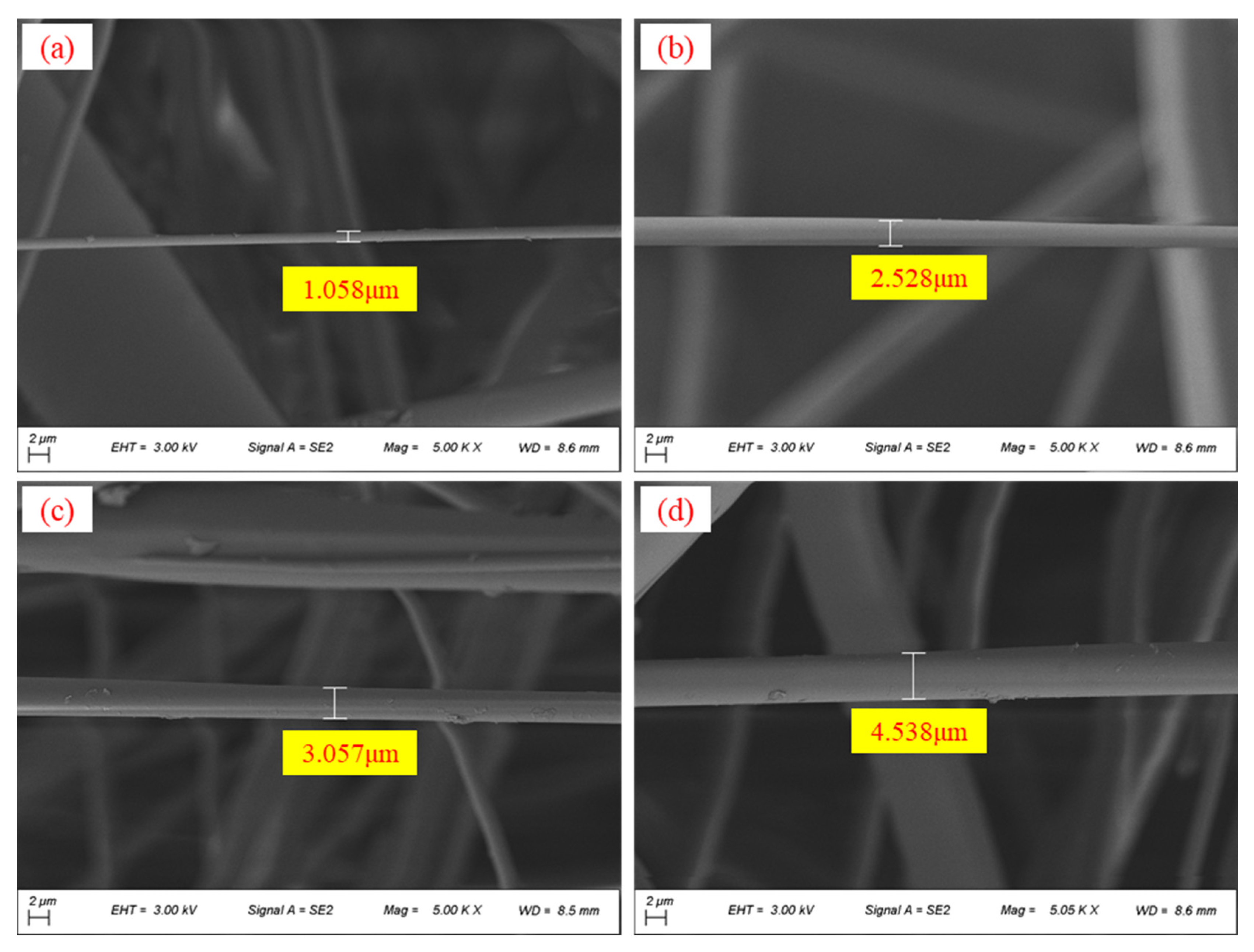
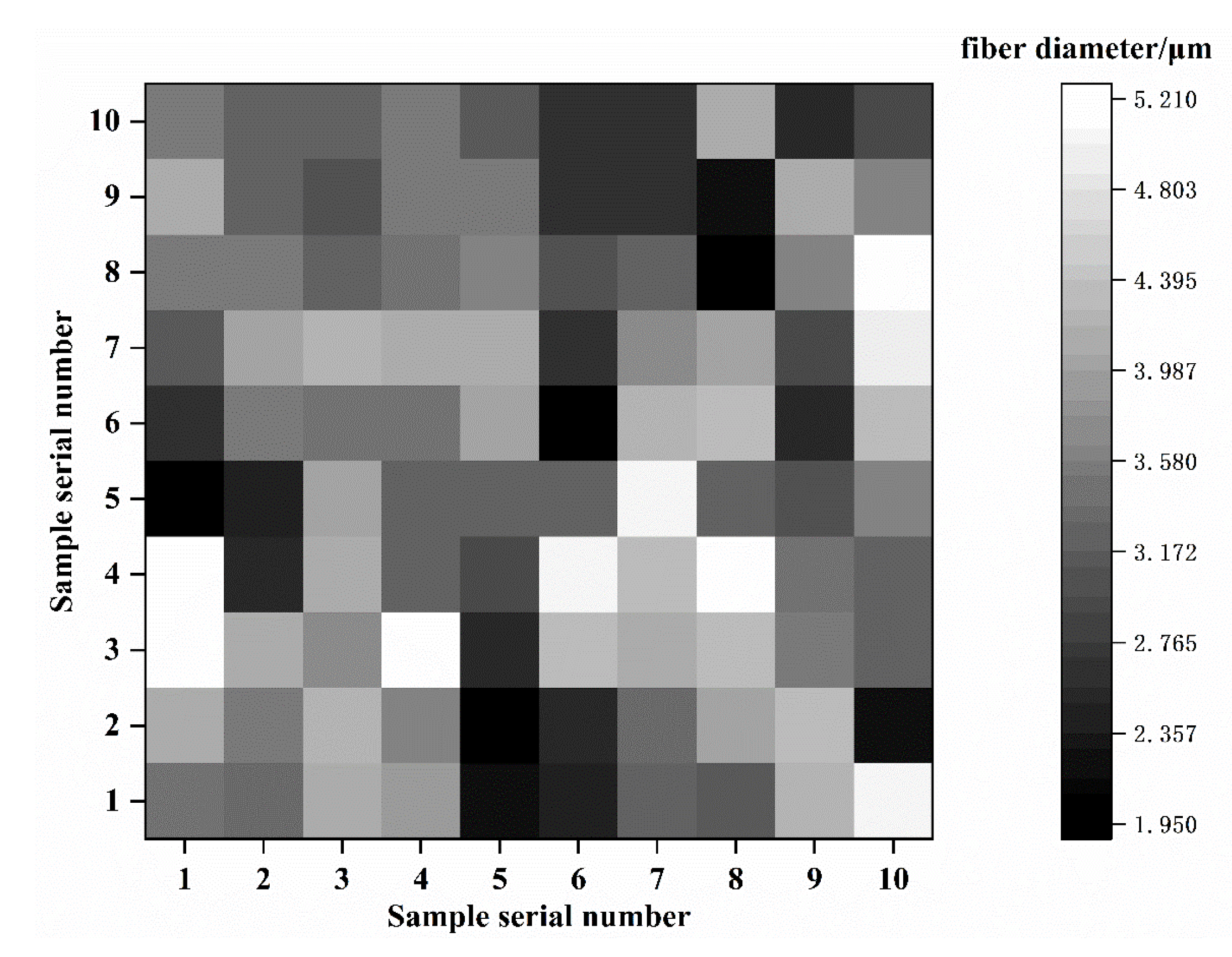

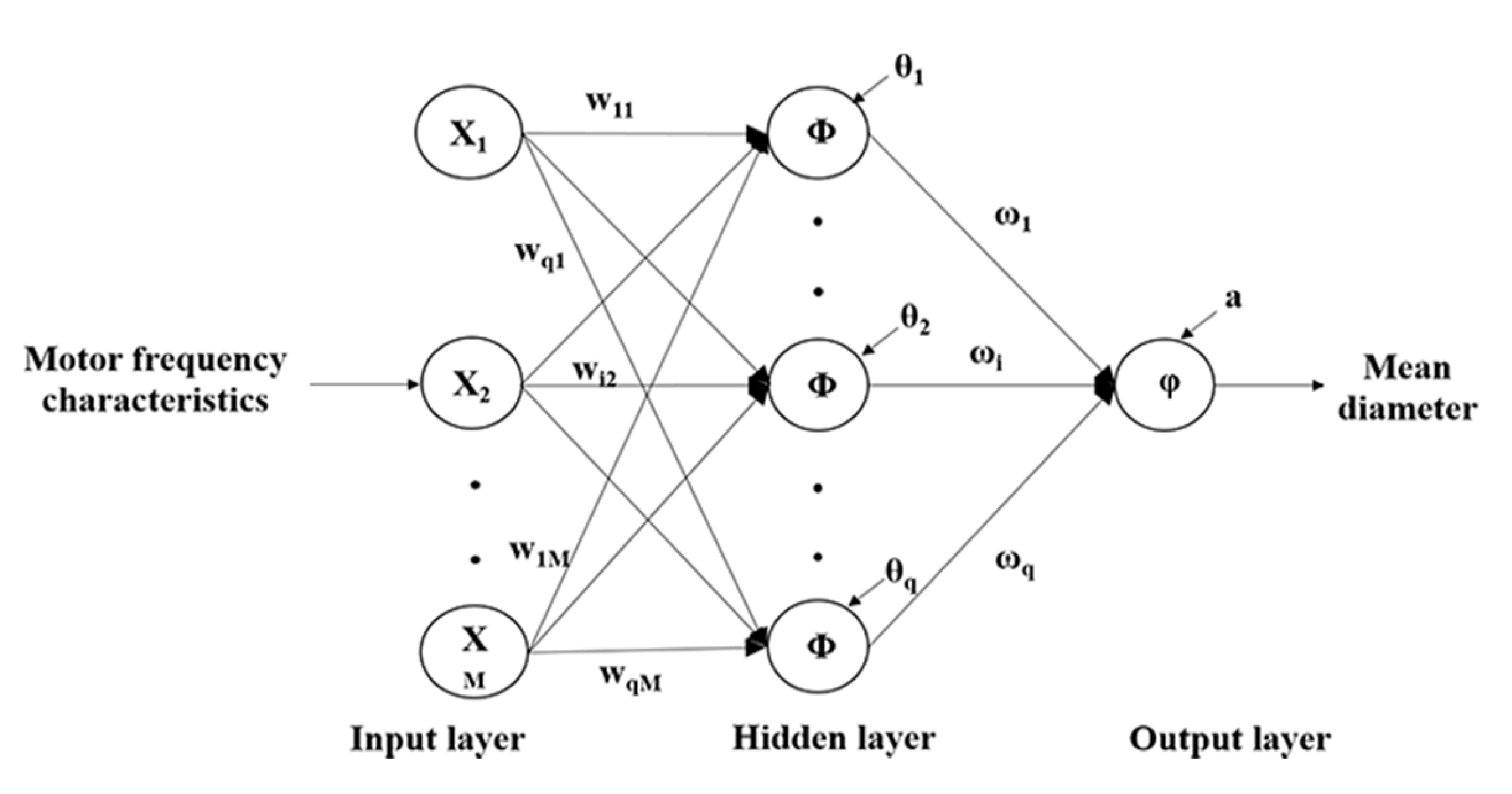

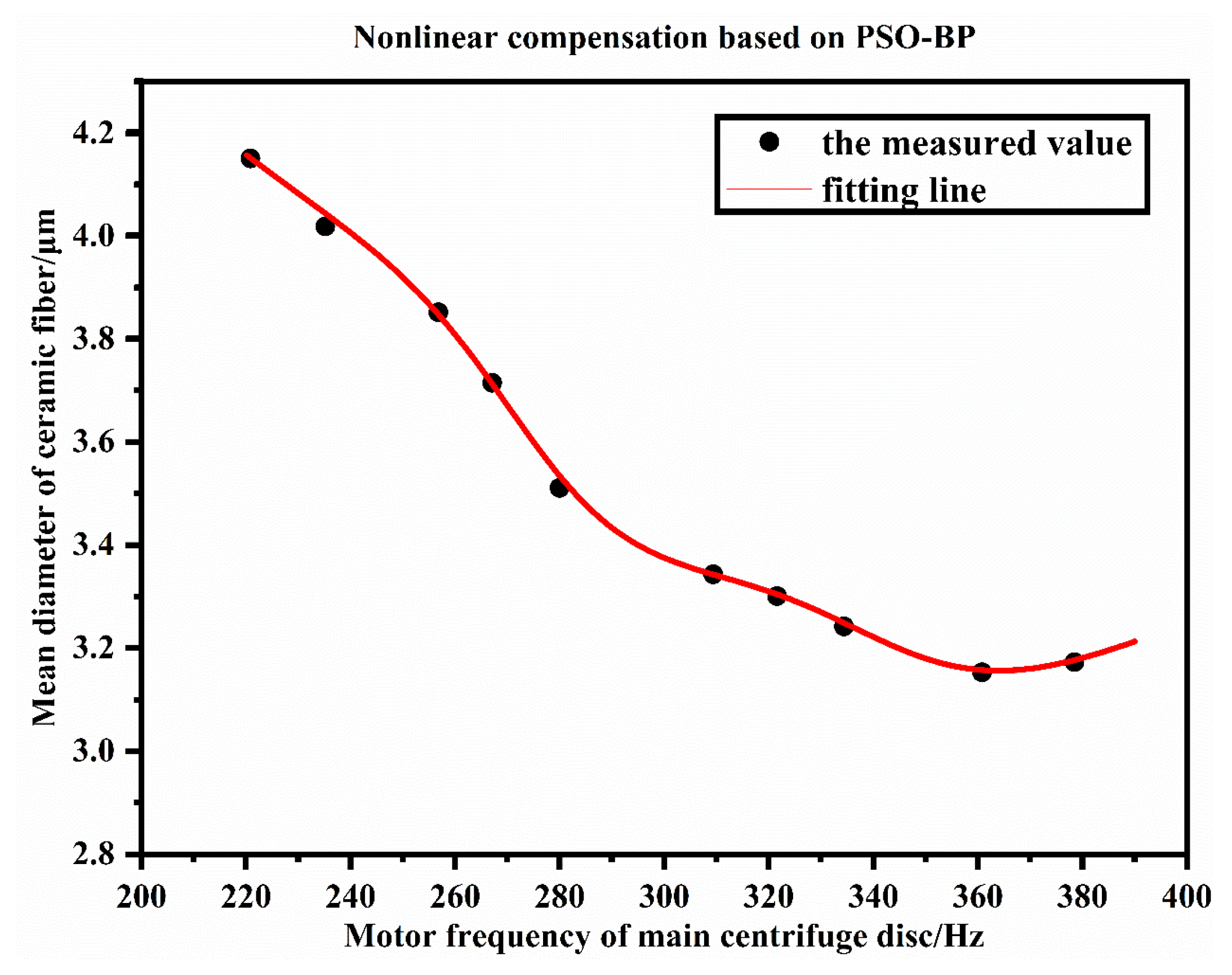
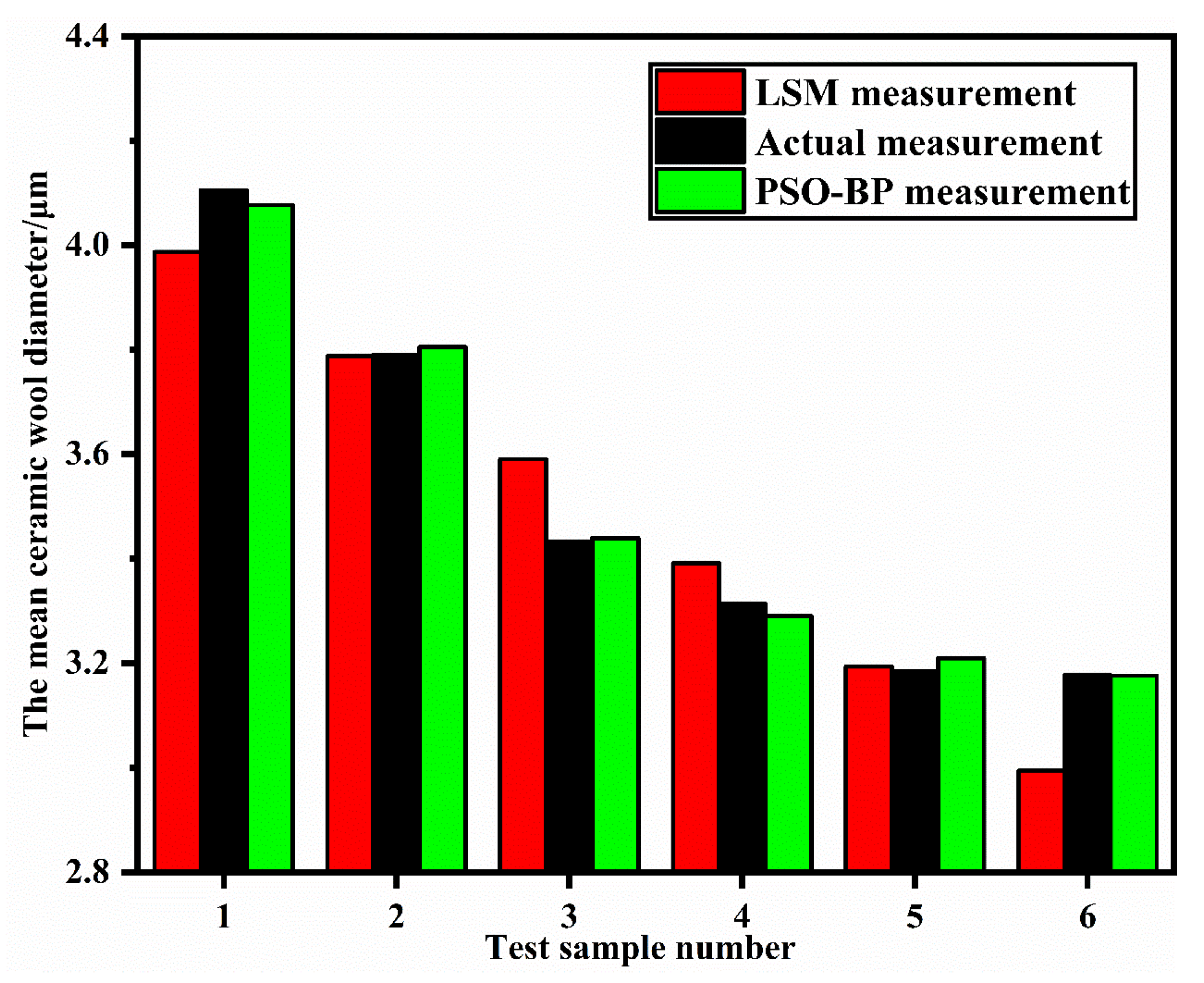
| The Main Motor Frequency/Hz | The Mean Diameter of Each Sample/μm | The Mean Ceramic Wool Diameter/μm | ||||
|---|---|---|---|---|---|---|
| 1 | 2 | 3 | 4 | 5 | ||
| 220.9 | 4.154 | 4.158 | 4.135 | 4.152 | 4.156 | 4.151 |
| 235.2 | 4.023 | 4.025 | 3.994 | 4.031 | 4.024 | 4.019 |
| 256.8 | 3.851 | 3.859 | 3.812 | 3.867 | 3.869 | 3.852 |
| 267.1 | 3.731 | 3.719 | 3.687 | 3.721 | 3.716 | 3.715 |
| 280.0 | 3.524 | 3.519 | 3.489 | 3.513 | 3.511 | 3.511 |
| 309.4 | 3.347 | 3.345 | 3.337 | 3.342 | 3.343 | 3.343 |
| 321.6 | 3.309 | 3.313 | 3.267 | 3.305 | 3.310 | 3.301 |
| 334.4 | 3.252 | 3.245 | 3.226 | 3.243 | 3.245 | 3.242 |
| 360.8 | 3.158 | 3.156 | 3.148 | 3.152 | 3.15 | 3.153 |
| 378.5 | 3.176 | 3.181 | 3.160 | 3.172 | 3.174 | 3.173 |
| Test Sample Number | Actual Mean Fiber Diameter/μm | LSM Measuring Results/μm | LSM Measuring Precision/% | PSO-BP Measuring Results/μm | PSO-BP Measuring Precision/% |
|---|---|---|---|---|---|
| 220.9 | 4.154 | 4.158 | 4.135 | 4.152 | 4.156 |
| 235.2 | 4.023 | 4.025 | 3.994 | 4.031 | 4.024 |
| 256.8 | 3.851 | 3.859 | 3.812 | 3.867 | 3.869 |
| 267.1 | 3.731 | 3.719 | 3.687 | 3.721 | 3.716 |
| 280.0 | 3.524 | 3.519 | 3.489 | 3.513 | 3.511 |
| 309.4 | 3.347 | 3.345 | 3.337 | 3.342 | 3.343 |
| 321.6 | 3.309 | 3.313 | 3.267 | 3.305 | 3.310 |
| 334.4 | 3.252 | 3.245 | 3.226 | 3.243 | 3.245 |
| 360.8 | 3.158 | 3.156 | 3.148 | 3.152 | 3.15 |
| 378.5 | 3.176 | 3.181 | 3.160 | 3.172 | 3.174 |
Disclaimer/Publisher’s Note: The statements, opinions and data contained in all publications are solely those of the individual author(s) and contributor(s) and not of MDPI and/or the editor(s). MDPI and/or the editor(s) disclaim responsibility for any injury to people or property resulting from any ideas, methods, instructions or products referred to in the content. |
© 2022 by the authors. Licensee MDPI, Basel, Switzerland. This article is an open access article distributed under the terms and conditions of the Creative Commons Attribution (CC BY) license (https://creativecommons.org/licenses/by/4.0/).
Share and Cite
Xu, T.; Huang, J.; Li, Y.; Chen, T. Predicting Ceramic Wool Diameter by Motor Frequency Using Improved BP Neural Network. Appl. Sci. 2023, 13, 226. https://doi.org/10.3390/app13010226
Xu T, Huang J, Li Y, Chen T. Predicting Ceramic Wool Diameter by Motor Frequency Using Improved BP Neural Network. Applied Sciences. 2023; 13(1):226. https://doi.org/10.3390/app13010226
Chicago/Turabian StyleXu, Tengzhou, Jie Huang, Yang Li, and Tao Chen. 2023. "Predicting Ceramic Wool Diameter by Motor Frequency Using Improved BP Neural Network" Applied Sciences 13, no. 1: 226. https://doi.org/10.3390/app13010226
APA StyleXu, T., Huang, J., Li, Y., & Chen, T. (2023). Predicting Ceramic Wool Diameter by Motor Frequency Using Improved BP Neural Network. Applied Sciences, 13(1), 226. https://doi.org/10.3390/app13010226





